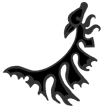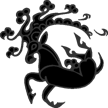A Greek speaking nomadic tribe, the history of the Thracians is closely tied to that of the Scythians, so that at times the two groups would seem inseparable.
 Herodotus wrote of the Thracian’s ability at working hemp fibres, and claimed that their clothes “were so like linen that none but a very experienced person could tell whether they were of hemp or flax; one who had never seen hemp would certainly suppose them to be linen.”
Herodotus wrote of the Thracian’s ability at working hemp fibres, and claimed that their clothes “were so like linen that none but a very experienced person could tell whether they were of hemp or flax; one who had never seen hemp would certainly suppose them to be linen.”
 Like the Scythian shamans, the Thracians used cannabis in a similar manner. Dr Sumach explains in A Treasury of Hashish that:
Like the Scythian shamans, the Thracians used cannabis in a similar manner. Dr Sumach explains in A Treasury of Hashish that:
 The sorcerers of these Thracian tribes were known to have burned female cannabis flowers (and other psychoactive plants) as a mystical incense to induce trances. Their special talents were attributed to the “magical heat” produced from burning the cannabis and other herbs, believing that the plants dissolved in the flames, then reassembled themselves inside the person who inhaled the vapors.
The sorcerers of these Thracian tribes were known to have burned female cannabis flowers (and other psychoactive plants) as a mystical incense to induce trances. Their special talents were attributed to the “magical heat” produced from burning the cannabis and other herbs, believing that the plants dissolved in the flames, then reassembled themselves inside the person who inhaled the vapors.
 Dionysus a Doper?
Dionysus a Doper? The majority of scholars are in agreement that Dionysus, the famous Greek God of Intoxication, was originally a Thracian god. Mircea Eliade, probably recognized as the foremost authority on the history of religion, has commented on the Thracian cult of Dionysus, and further he has connected this worship with the use of cannabis:
The majority of scholars are in agreement that Dionysus, the famous Greek God of Intoxication, was originally a Thracian god. Mircea Eliade, probably recognized as the foremost authority on the history of religion, has commented on the Thracian cult of Dionysus, and further he has connected this worship with the use of cannabis:
 Prophecy in Thrace was connected with the cult of Dionysus. A certain tribe managed the oracle of Dionysus, the temple was on a high mountain, and the prophetess predicted the future in ‘ecstacy’, like the Pythia at Delphi.
Prophecy in Thrace was connected with the cult of Dionysus. A certain tribe managed the oracle of Dionysus, the temple was on a high mountain, and the prophetess predicted the future in ‘ecstacy’, like the Pythia at Delphi.
 Ecstatic experiences strengthened the conviction that the soul is not only autonomous, but that it is capable of union mystica with the divinity. The separation of soul from body, determined by ecstacy, revealed on the one hand the fundamental duality of man, on the other, the possibility of a purely spiritual post-experience, the consequence of ‘divinization’. Ecstacy could …be brought on by certain dried herbs or by asceticism.
Ecstatic experiences strengthened the conviction that the soul is not only autonomous, but that it is capable of union mystica with the divinity. The separation of soul from body, determined by ecstacy, revealed on the one hand the fundamental duality of man, on the other, the possibility of a purely spiritual post-experience, the consequence of ‘divinization’. Ecstacy could …be brought on by certain dried herbs or by asceticism.
 In a foot note to dried herbs, Eliade commented on the use of “Hemp seeds among the Thracians… and among the Scythians”, and refers to some of the ancient shamans as “those who walk in smoke” or Kapnobatai. The Kapnobatai would be dancers and Shamans who used the smoke of hemp to bring ecstatic trances.
In a foot note to dried herbs, Eliade commented on the use of “Hemp seeds among the Thracians… and among the Scythians”, and refers to some of the ancient shamans as “those who walk in smoke” or Kapnobatai. The Kapnobatai would be dancers and Shamans who used the smoke of hemp to bring ecstatic trances.
 The messages from the other world brought back by these ancient Shamans was taken as authoritative advice by the ancient chieftains and their tribes. In this sense, the Shamans acted as the conscience or mind of the whole group.
The messages from the other world brought back by these ancient Shamans was taken as authoritative advice by the ancient chieftains and their tribes. In this sense, the Shamans acted as the conscience or mind of the whole group.
 Mellowing with Time
Mellowing with Time It could well be that in later times the cannabis smoke had somewhat mellowed the Scythians, and their spiritual leaders directed them towards becoming a more civilized people. The ancient Greek historian Ephorus wrote in the fourth century BC that the Scythians ‘feed on mares milk and excel all men in justice’. His comments were followed in the first century BC by Strabo, who wrote that ‘we regard the Scythians as the most just of men and the least prone to mischief, as also far more frugal and independent of others than we are.’
It could well be that in later times the cannabis smoke had somewhat mellowed the Scythians, and their spiritual leaders directed them towards becoming a more civilized people. The ancient Greek historian Ephorus wrote in the fourth century BC that the Scythians ‘feed on mares milk and excel all men in justice’. His comments were followed in the first century BC by Strabo, who wrote that ‘we regard the Scythians as the most just of men and the least prone to mischief, as also far more frugal and independent of others than we are.’
Next Issue: A Hemp Heresy Probably the most famous of the ancient Shamans who were directly influenced by the Scythian technique of ecstacy through cannabis were Moses, Isaiah, Ezekeil, and some of the other Old Testament Prophets and kings. A grandiose claim? Is the Philosopher stoned? A Hemp Heresy? Join ‘When Smoke Gets in My I’ next month for an in depth look at cannabis in the Old Testament.
Probably the most famous of the ancient Shamans who were directly influenced by the Scythian technique of ecstacy through cannabis were Moses, Isaiah, Ezekeil, and some of the other Old Testament Prophets and kings. A grandiose claim? Is the Philosopher stoned? A Hemp Heresy? Join ‘When Smoke Gets in My I’ next month for an in depth look at cannabis in the Old Testament.
 BOOM SHIVA
BOOM SHIVA